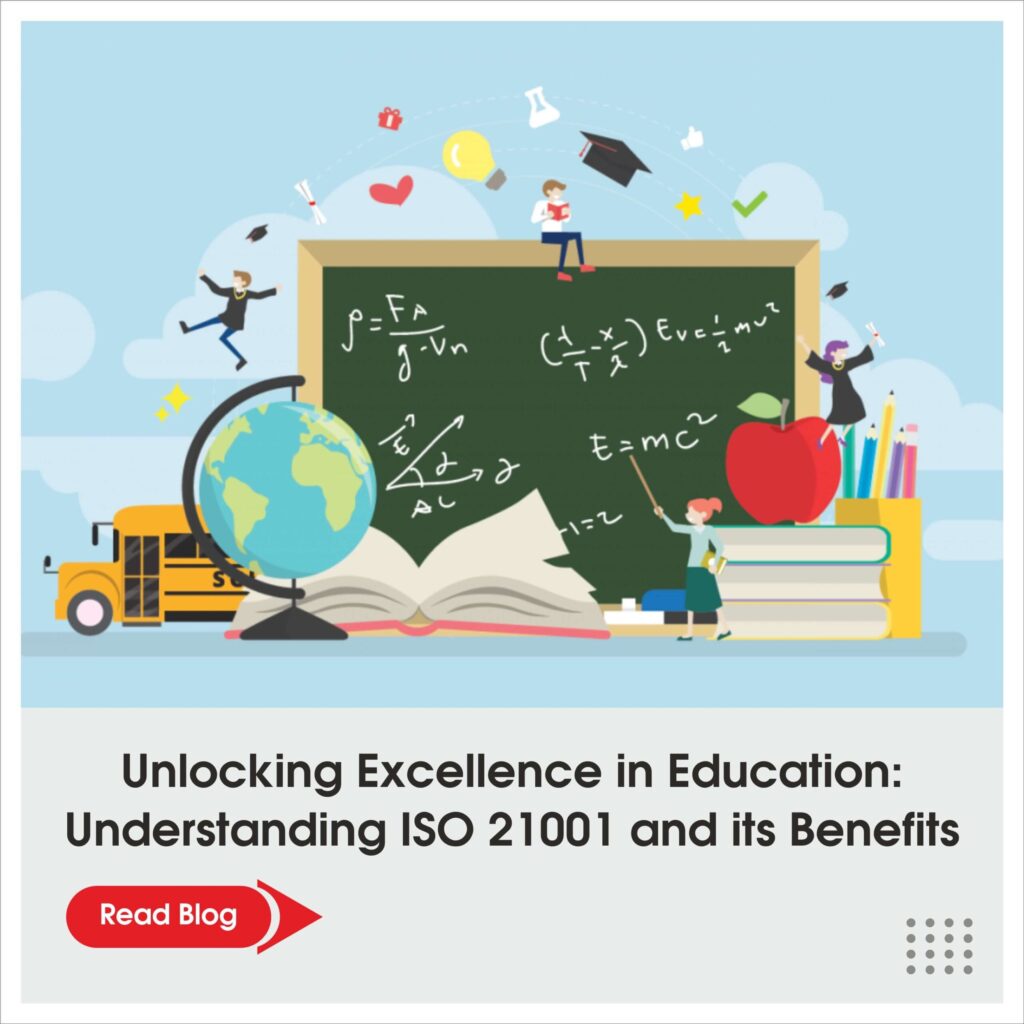Unlocking Excellence in Education: Understanding ISO 21001:2018 and its Benefits

ISO 21001 is an international standard developed by the International Organization for Standardization (ISO) that provides management tools for organizations that offer educational products and services. It aims to help educational providers meet students’ requirements and needs. The standard was first published in 2018 and is applicable to all organizations involved in the educational sector, such as schools, universities, distance learning centres, corporations, and non-profit or governmental organizations. The ISO 21001 standard is based on the ISO 9001 Quality Management Systems standard but is tailored specifically for the educational sector. It includes a set of guidelines and principles that focus on the specific needs and challenges of educational institutions, with an emphasis on enhancing the satisfaction of learners and other beneficiaries. Understanding ISO 21001:2018 Educational Organizational Management System (EOMS): The standard establishes an Educational Organizational Management System (EOMS) to ensure that the organization can consistently provide a product that meets the learner’s and other beneficiaries’ needs. Quality and Competence: ISO 21001 emphasizes quality education and competence. It ensures that educational organizations are competent in providing effective learning opportunities. Inclusivity: The standard promotes inclusivity by encouraging educational organizations to understand and respond to the diverse needs of their learners. Life-long Learning: ISO 21001 supports the concept of lifelong learning, recognizing that education is not confined to traditional classroom settings or specific periods in a person’s life. The key benefits of implementing ISO 21001:2018 Improved Educational Processes: By implementing the standard, educational organizations can streamline their processes, making them more efficient and effective. This can lead to improved educational outcomes. Enhanced Learner Satisfaction: The standard focuses on meeting the needs and expectations of learners. As a result, learner satisfaction can be enhanced. Increased Credibility: Being certified to ISO 21001 can increase an organization’s credibility in the eyes of stakeholders, including learners, parents, governmental bodies, and potential partners. Risk Management: The standard helps educational organizations identify and manage risks associated with their activities, thus ensuring a safer and more secure learning environment. Inclusive and Equitable Quality Education: ISO 21001 supports the United Nations Sustainable Development Goal 4 – to ensure inclusive and equitable quality education and promote lifelong learning opportunities for all. ISO 21001 implementation in your educational centre can turn regulatory requirements into the source of the constant development of students as well as the surroundings of the institution. If you follow a detailed directive, you reduce the time needed for start-up and guarantee that you comply with the established requirements for your organization. Start with an introduction in the ISO 21001 which includes its (ISO 21001) requirements. Under this international standard, the schools are concerned, and the framework is developed on the fundamental approach for the design, implementation, operation, and improvement of the educational organisational management system (EOMS). With the knowledge of the main ideas and aims of the ISO 21001 standard, one will have the ground to build the entire structure on. Thus, check your institution’s current practices versus the criteria of ISO 21001. Establish whether there is any gap or necessity for improvement this shortcoming should be corrected. This assessment will be your primary tool in identifying the incentives and assistance required to ensure the success of the implementation. Now that you have ascertained your deficiencies, figure out your action plan. The suggested plan should explicitly declare concrete actions, assign a person responsible, set deadlines, and identify milestones structured in a manner that will help you through the process. It is pertinent to include all the stakeholders comprising the administration, teachers, and staff in the planning phase of ISO 21001 so that everyone is in the same wave of the organization. Make fund placement available for implementation. Financial resources as well as human resources should be part of these resources to ensure a successful outcome. Employees will need to be trained with the nature of their position and the EOMS framework into which they belong. Moreover, there is a need to adopt the technology or the software proposed which can assist the data entry and documentation procedures required for ISO 21001. Effective communication in the whole implementation process is of great significance. Be sure that all the stakeholders understand the overall purpose of and the advantages of implementing ISO 21001. Continuously provide them with the updates on the progress, and respond promptly to their questions and concerns as the journey goes on. Furthermore, keep an eye on and assess your organization’s progress toward achieving ISO 21001 compliance on a continual basis. To verify that the standard is being followed, internal or external certifying organizations should do routine audits. You may establish a culture of continuous improvement and provide your students access to a top-notch learning environment by using this step-by-step guide to apply ISO 21001 at your educational institution. Educational establishments can achieve excellence in education by comprehending and putting into practice ISO 21001, offering top-notch learning opportunities that satisfy the various demands of every student.
